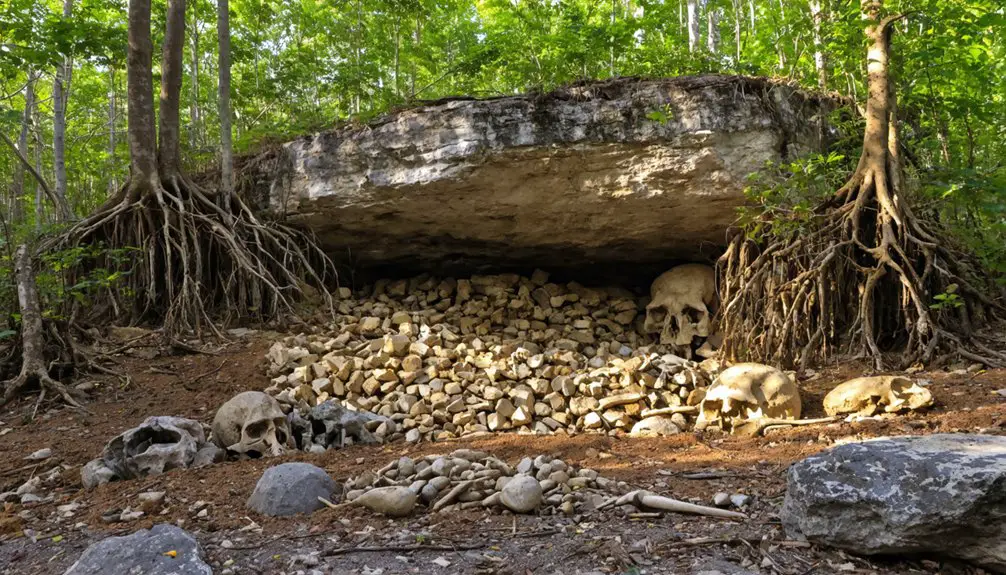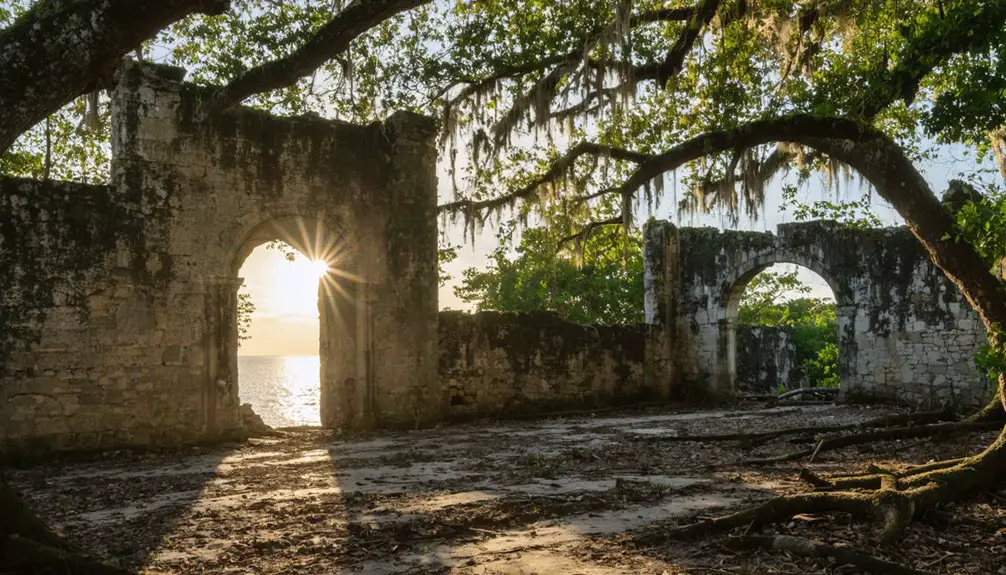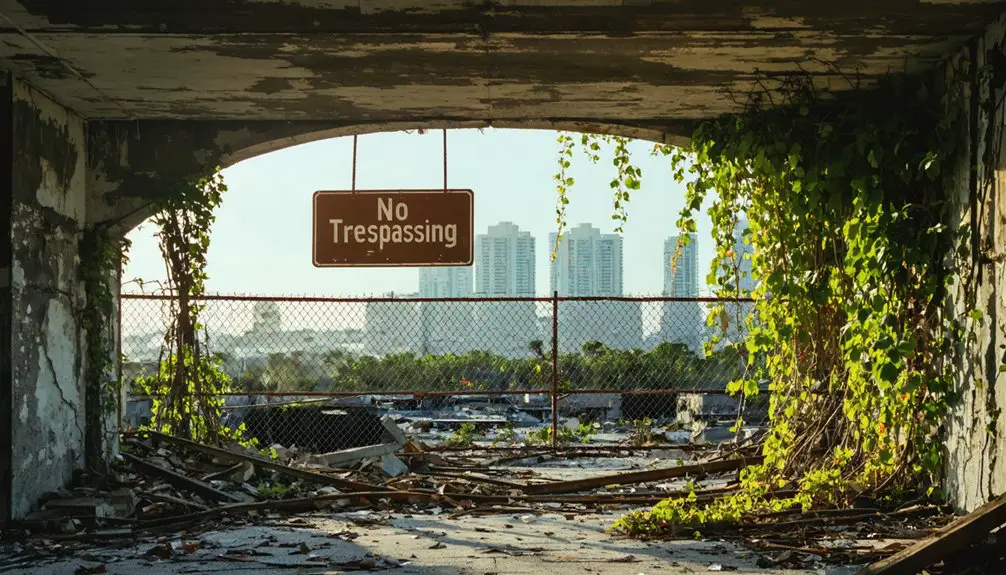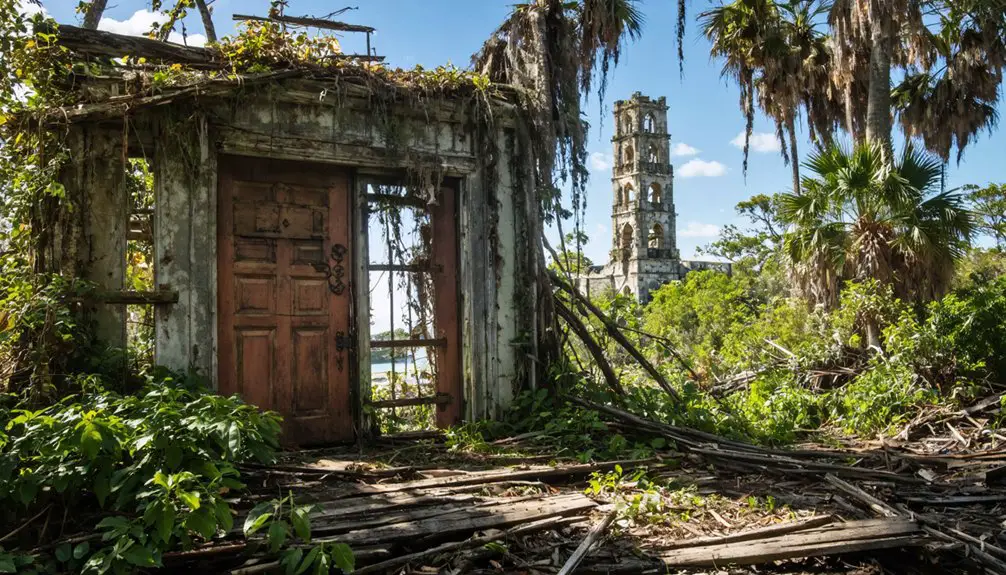You’ll find Cutler’s ghost town remnants along Florida’s Biscayne Bay, where a bustling pioneer settlement once thrived in the 1880s. William Fuzzard established the first homestead there in 1883, leading to a community that grew to 75 residents with essential shipping wharves and agricultural operations. When Henry Flagler’s railroad bypassed the town in 1915, Cutler vanished into history, though its legacy lives on through the preserved Deering Estate’s 454 acres of protected land.
Key Takeaways
- Cutler was a thriving agricultural community established in 1883, featuring wharves and shipping facilities along Biscayne Bay in Southeast Florida.
- The town’s decline began in 1915 when Charles Deering acquired the land, dismantling most structures except Richmond Cottage.
- Transportation changes, including Flagler’s railroad bypassing the area, contributed significantly to Cutler’s transformation into a ghost town.
- The former town site is now part of the 454-acre Deering Estate, preserving the area’s historical significance.
- Only ruins and historical markers remain of the original settlement, which once had 75 residents and served as a vital shipping port.
The Birth of a Pioneer Settlement (1880s)
While Dr. William Cutler dreamed of creating a farming utopia on his 600-acre purchase, it was William Fuzzard who truly sparked pioneer dreams in this untamed slice of Florida.
In 1883, Fuzzard established his homestead on the Perrine Grant lands, setting the foundation for what would become Cutler. You’ll find the settlement’s origins rooted along a natural limestone formation known as “The Reef,” where early settlers faced the raw wilderness of Biscayne Bay. The area’s Southeast Florida location made it an ideal spot for agricultural development. The establishment of a public road in 1895 helped connect the growing settlement to neighboring communities.
Despite settlement challenges and Dr. Cutler’s unsuccessful attempts to attract more farmers to his vision, a hardy few made this coastal haven their home.
The establishment carved its place in history as one of Miami-Dade’s earliest pioneer communities, marking its territory with a crucial post office and creating the beginnings of a promising agricultural settlement.
William Fuzzard’s Legacy and Old Cutler Road
As you follow the winding path of Old Cutler Road today, you’re tracing William Fuzzard‘s pioneering footsteps from 1884, when he first carved an important trail connecting Cutler to Cocoanut Grove.
Fuzzard’s vision for connecting South Florida’s communities materialized when his rough trail became an official public road in 1895, establishing a significant transportation link for farmers shipping their harvests. He had established himself as a first postmaster of Cutler while helping build the growing community.
With Cutler’s population reaching 75 residents by late 1884, Fuzzard’s transportation route became vital to the town’s growth and commerce.
This historic thoroughfare stands as Fuzzard’s most enduring legacy, weaving through Miami-Dade County as a lasting reminder of Cutler’s pioneer days and the essential role of early transportation networks in South Florida’s development.
Trail Blazing Pioneer Days
When William Fuzzard established his homestead in 1883 on the disputed Perrine Grant lands near Biscayne Bay, he set in motion a series of pioneering developments that would shape South Florida’s early infrastructure.
You’ll find his most lasting contribution in the trail he blazed from Cutler to Coconut Grove around 1884. Despite pioneer challenges and settlement struggles, Fuzzard carved this essential 15-mile path through limestone ridge, pine rocklands, and hardwood hammocks.
As Cutler’s first postmaster, he even converted a rescued freight car into the town’s post office. His agricultural ventures included managing the Biscayne Starch Factory and cultivating pineapples, citrus, and guavas. The area’s population quickly grew to 75 residents by 1884 as Fuzzard’s transportation improvements made the region more accessible.
Building South Florida’s Connection
Through his pioneering efforts to connect South Florida’s early settlements, William Fuzzard left an enduring mark on the region’s infrastructure with the creation of Old Cutler Road.
As Cutler’s first postmaster, he established pioneer infrastructure by converting a freight car into a post office and blazed a crucial trail that would transform regional commerce.
You’ll find Fuzzard’s legacy reflected in three key developments:
- A fifteen-mile limestone trail that became Old Cutler Road in 1895
- Agricultural processing operations, including a starch factory and fruit cultivation
- Mail service connections that linked isolated communities until 1915
This trail, following natural ridges through pine rocklands and hammocks, provided the first reliable overland route between Cutler and Coconut Grove, enabling trade and communication in South Florida’s challenging terrain.
Historic Road’s Lasting Impact
Today’s travelers along Old Cutler Road follow the exact path William Fuzzard blazed in 1884, connecting Cutler to Coconut Grove along a natural limestone ridge.
You’re literally tracing pioneer footsteps on this historic route, which has outlived the ghost town it once served.
While Cutler’s farming community vanished after being bypassed by Flagler’s railroad in 1903, Fuzzard’s legacy endures through this iconic roadway.
The road’s cultural significance earned it State Historic Highway status in 1974, preserving its rural character amid Miami’s urban sprawl.
The road, once known as Ingraham Highway until 1935, reflects the evolving history of South Florida’s development.
You’ll find the route’s original charm intact, with its shaded corridor now accommodating modern recreational uses.
The path that once transported pineapples and citrus continues to connect South Floridians, though now more for pleasure than commerce.
Native American Heritage Along Biscayne Bay
Long before Cutler became a ghost town, the shores of Biscayne Bay teemed with indigenous life dating back at least 10,000 years to the Paleo-Indian Period.
These early inhabitants roamed a dry, grassy savannah – now submerged beneath the bay – hunting megafauna like mammoths. As sea levels rose, the Tequesta traditions emerged around 500 BCE, mastering the art of harvesting marine resources from the evolving coastline.
Their fishing and shellfish gathering lifestyle enabled the development of rich artistic traditions and complex social structures.
The Tequesta people thrived in the region for nearly 2,000 years, establishing permanent settlements along the Miami River.
You’ll discover fascinating evidence of their maritime lifestyle through:
- Shell middens scattered along the coast, revealing their resourceful use of conch and whelk
- The Miami Circle, a mysterious 2,000-year-old limestone structure at Brickell Point
- Seasonal camps built on bay islands to escape mainland mosquitoes
The Tequesta’s territory stretched from Palm Beach to the Keys, where they lived freely until Spanish contact in 1565.
Archaeological Treasures at the Cutler Fossil Site

Deep beneath Florida’s limestone bedrock, the Cutler Fossil Site stands as one of North America’s most significant Pleistocene discoveries, yielding thousands of fossils from 47 mammal species.
You’ll find evidence of extinct megafauna like mammoths, mastodons, and sabertooth cats alongside modern animals, revealing the site’s remarkable fossil significance. Located at Charles Deering Estate Park, the site remains protected from public access to preserve its archaeological integrity.
What’s particularly fascinating are the paleoenvironmental insights from human activity at the site. You can trace ancient hunters‘ presence through burned bones, stone tools, and burial grounds dating back nearly 11,000 years.
The site served as both a temporary hunting camp and permanent settlement, where at least five individuals once lived. Their tools, made from imported chert and modified marine shells, tell a story of trade and adaptation in a changing post-Ice Age landscape.
The sinkhole’s discovery in 1979 began when locals searching for wood stumbled upon fossil horse teeth that sparked extensive archaeological investigation.
The Railroad Decision That Changed Everything
When Henry Flagler set his sights on expanding the Florida East Coast Railway southward in 1903, you’d find over 150 laborers clearing paths through dense vegetation along the Miami River’s south bank.
This railroad expansion faced significant hurdles with the Perrine Grant land dispute, but Flagler’s determination to reach Key West wouldn’t be stopped.
The decision to build through Cutler proved transformative, driven by three key factors:
- Florida Legislature’s doubled land grants (8,000 acres per mile)
- Vast agricultural development potential near Cutler Ridge
- Strategic positioning for further expansion to Homestead
Charles Deering’s Lasting Impact on the Region

Charles Deering’s influence on South Florida stretches far beyond his era as a wealthy industrialist and art collector. When you look at his 444-acre Cutler estate, you’ll find the largest coastal forest preserved in the U.S., complete with mangroves, hardwood hammocks, and pine rocklands that might’ve otherwise vanished to development.
His ecological preservation efforts weren’t just about protecting land – he partnered with botanists John Kunkel Small and Charles Torrey Simpson to create an experimental farm that balanced agriculture with conservation.
You can still see Deering’s influence today through the estate’s continued role in arts and education. After surviving Hurricane Andrew and undergoing a $7.2 million restoration, the property remains a monument to his vision of combining cultural heritage with environmental stewardship.
Preserving History Through Estate Lands
Since Miami-Dade County’s landmark purchase of 346 acres in 1985, the Deering Estate has grown to encompass over 454 acres of protected land that’s managed by the county’s Parks Department.
You’ll discover a living museum where heritage conservation meets ecological preservation, protecting both natural landscapes and cultural treasures spanning 10,000 years of history.
The estate’s preservation efforts focus on three key areas:
The Deering Estate’s preservation mission spans archaeological treasures, historic landmarks, and vital coastal ecosystems, safeguarding South Florida’s precious heritage.
- Archaeological sites including the Cutler Fossil Site with Pleistocene-era remains and Paleo-Indian artifacts
- Historic structures and trails, including Old Cutler Road, designated as a State Historic Highway in 1974
- South Florida’s rare Atlantic Coastal Ridge ecosystems, featuring submerged aquatic vegetation
You can explore this rich heritage through guided tours, workshops, and cultural events that bring the region’s past to life.
Modern Development Challenges and Controversies

Although Cutler’s ghost town status has intrigued visitors for decades, modern development efforts face significant hurdles that pit preservation against progress.
You’ll find strong community resistance against large-scale redevelopment, with locals fighting to maintain their town’s unique character despite its abandoned state.
Infrastructure challenges plague potential projects, as the area’s existing roads, utilities, and emergency services can’t support increased population density.
Rising insurance costs and market uncertainties have forced developers to postpone or cancel projects entirely.
When you factor in Florida’s harsh environmental conditions – from hurricane risks to corrosive sea air – the obstacles multiply.
Legal battles and zoning disputes further complicate matters, while environmental regulations designed to protect sensitive ecosystems create additional hurdles for anyone hoping to breathe new life into this historic area.
A Historic Highway’s Enduring Legacy
Today you’ll find Old Cutler Road following the same natural Atlantic Coastal Ridge pathway that Native Americans and early settlers used to stay above annual floodwaters.
As one of Miami’s first overland routes, this historic trail began in 1884 when William Fuzzard carved out a path connecting the pioneer town of Cutler to Coconut Grove.
The road’s preservation as a state historic highway since 1974 helps protect its winding curves and tree canopies, offering you a glimpse into South Florida’s pioneer past.
Pathway Through Pioneer Times
When pioneers first carved their paths through northeast Florida’s wilderness, they unknowingly laid the foundation for centuries of transportation history.
You’ll discover how these trails evolved from Native American footpaths into colonial highways like Kings Road, marking essential cultural intersections between indigenous peoples, European settlers, and early Americans.
Today, you can explore this rich heritage through:
- Heritage Crossroads’ 98-mile scenic route, showcasing plantation ruins and pioneer settlements
- Historic markers that trace the paths of colonial military campaigns and early settler movements
- Preserved segments of original roadways, including portions built by enslaved laborers between 1765-1773
These transportation corridors didn’t just connect communities – they shaped the region’s destiny, from the British colonial period through the 1920s real estate boom, leaving an indelible mark on Florida’s landscape.
Natural Ridge Road Route
A natural limestone ridge, historically known as “The Reef” by pioneers, formed the geographic foundation for Old Cutler Road‘s historic route along Biscayne Bay.
You’ll find this elevated pathway served as nature’s gift to early settlers, providing an essential overland route through South Florida’s challenging wetlands and hardwood hammocks.
The unique ridge ecology supported both pioneer communication and agricultural development, as William Fuzzard and other trailblazers carved out the first path in 1883.
The limestone formation you’re traveling on has shaped settlement patterns for over a century, hosting everything from Native American settlements to modern suburban developments.
Today, you can still experience this geological landmark’s significance while driving along Old Cutler Road, designated as a State Historic Highway in 1974.
Historic Preservation Today
Since the acquisition of 346 acres from Charles Deering’s heir in 1985, the Deering Estate at Cutler has emerged as the cornerstone of historic preservation along Old Cutler Road.
You’ll find this historic site preservation marvel showcasing over 10,000 years of South Florida history, from Paleo-Indian settlements to the Deering family’s legacy.
After Hurricane Andrew‘s devastating impact in 1992, the estate underwent a remarkable $7.2 million restoration, demonstrating unwavering commitment to cultural resource management.
Today, the estate offers:
- Artist residency programs hosting over 90 creatives since 2006
- Archaeological research access to the Cutler Fossil Site, featuring Pleistocene-era discoveries
- Educational partnerships with institutions like FIU and Miami-Dade College, ensuring the site’s living legacy continues through scholarly engagement
From Bustling Port to Preserved Heritage Site
Though Dr. William Cutler never lived there, the town bearing his name emerged as a vibrant pioneer agriculture settlement in the 1880s.
You’ll find its roots traced to William Fuzzard, who established the first trail connecting the area to Coconut Grove and served as the town’s postmaster when its population reached 75 residents.
Cutler’s prosperity centered around its strategic port location, with two bustling wharves supporting thriving fruit cultivation.
The coastal wharves of historic Cutler served as vital arteries for shipping locally grown fruit to distant markets.
The town boasted essential amenities including the Richmond Cottage hotel, a school, and daily mail service.
However, economic decline struck swiftly when the Florida East Coast Railroad bypassed Cutler in 1903.
By 1915, Charles Deering had incorporated the ghost town into his estate, preserving only Richmond Cottage while dismantling other structures.
Today, this preserved heritage site tells the story of South Florida’s dramatic transformation.
Frequently Asked Questions
What Was the Population of Cutler During Its Peak Years?
You’ll find Cutler’s peak population isn’t precisely documented in its history, but demographic studies suggest it was likely in the low hundreds before declining after 1903’s railroad bypass.
Were There Any Schools or Churches in the Original Cutler Settlement?
You’ll find Cutler’s school history includes the 1896 schoolhouse serving local children, but there’s no evidence of formal churches – residents likely worshipped privately or traveled to nearby communities for religious services.
What Businesses and Industries Operated in Cutler Before Its Decline?
You’d think tiny Cutler was just farms, but you’ll find it had two general stores, shipping wharves, a hotel, plus tomato and pineapple farming practices that dominated local business until 1903.
Did Any Notable Shipwrecks Occur Near Cutler’s Biscayne Bay Port?
You’ll find over 40 shipwrecks near Cutler, including the 1733 Spanish vessel Nuestra Senora del Popolo and 1748’s HMS Fowey – both casualties of maritime trade routes through treacherous Biscayne Bay waters.
How Did Residents Get Their Drinking Water in Early Cutler?
For over 12,000 years, you’d find your drinking water by gathering directly from a limestone-lined creek and natural spring. These water sources sustained residents without any early infrastructure like pipes or pumps.
References
- https://www.uflib.ufl.edu/spec/ingraham/expedition/Cutler.htm
- https://communitynewspapers.com/featured/but-waitour-history-truly-begins-in-1895/
- https://www.cutlerbay-fl.gov/sites/default/files/fileattachments/community/page/6371/04-press_release_-_additional_information-history_of_property_at_18551_old_cutler_road.pdf
- https://en.wikipedia.org/wiki/Charles_Deering_Estate
- https://www.youtube.com/watch?v=nL_LFJqUCTE
- https://en.wikipedia.org/wiki/Old_Cutler_Road
- https://www.uflib.ufl.edu/spec/inhouse/Matthews_Deering_text.pdf
- https://www.cutlerbay-fl.gov/community/page/settlement-southern-miami-dade
- https://en.wikipedia.org/wiki/Cutler
- https://www.uflib.ufl.edu/spec/ingraham/expedition/FuzzardW.htm



